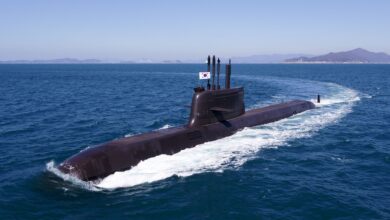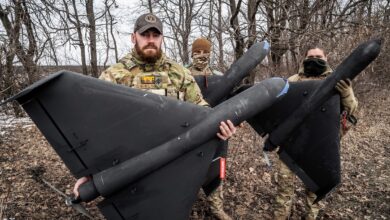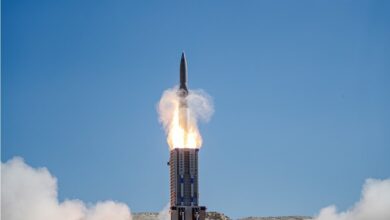
The United States, once the primary architect of the post-war Arctic order, has abandoned the High North.
With just one half-decade-old icebreaker, no deep-water ports, and missing geopolitical strategy, American presence in the Arctic is vestigial. Our northerly airbases and monuments are artifacts, eyesores for passing Chinese ships.
It is time for the United States to build from its rich past in the region and embark on a historic venture: a Marshall Plan for the Arctic.
Treasure Trove
In the popular imagination, the Arctic is a barren wasteland, dotted with survivalists and the occasional airstrip. In reality, however, the region possesses a treasure trove of resources and opportunity.
Nearly 13 percent of the world’s undiscovered oil and 30 percent of undiscovered natural gas are likely buried beneath the sea-ice and snow. Mineral resources like nickel, zinc, and precious metals are also abundant.
As temperatures rise, these resources are becoming cheaper to extract. They are also becoming more affordable to transport as global warming is opening the Northeast Passage, a sea route that drastically reduces shipping times from China and the Russian Far East to Europe.
Sino-Russian Cooperation in the Arctic
Seeing the potential for profit and power, China is working through its cadre of government-owned corporations to exert control over the Arctic. The People’s Republic claims a “near-Arctic” identity and legitimizes its acquisitions and expansion based on their adjacency.
Given that China is nearly 1,850 miles away from the Arctic, Russian infrastructure and support are essential for its expansion. Collaborating on everything from pipelines to maritime research stations, the Sino-Russian alliance is nascent, but is growing and could become a force to be reckoned with as the region heats up.
The Chinese government has an Arctic Marshall Plan of their own: the “Polar Silk Road.” They have already integrated into Greenlandic rare earth mineral mines, made free trade agreements with Iceland, acquired a controlling share in Norwegian Air, and built a network of Confucius Institutes throughout Scandinavia.
Chinese investments are part of their larger geostrategy, referred to by People’s Liberation Army Navy officials as “near seas defense, far seas protection, oceanic presence, and expansion into the two poles.” In the face of America’s decades-long abdication of responsibility in the Arctic, the High North is becoming yet another annex of China’s goliath Belt and Road Initiative.

Unless the United States steps up to defend American interests and the sovereignty of all Arctic nations, the region will fall to a state shamelessly operating an internment camp archipelago.
The United States has three key concerns in the Arctic. The prosperity and security of Arctic Americans is its preeminent interest. The second is ensuring the defense of the United States, the North American continent, and our Arctic NATO allies. The third is to protect American access to newly available Arctic resources to defend development and investment rights.
None of these three goals can be met without maintaining a free and fair order that allows for peaceful negotiation and guarantees national sovereignty.
American Investment in the Arctic
During the Second World War, NATO countries invested heavily in Greenland and Iceland, using the two countries as forward operating bases for American warplanes and supplies.
When Denmark fell to the Germans, the US established Greenland as a de facto protectorate – issuing a local currency, stamps, rationing, and daylight savings time. Along with the import of American customs and goods came strategic investment in infrastructure and business. The US Army also commandeered the Greenland town Ivigtut’s cryolite source, a commercially extinct mineral used to refine aluminum, then a major source of income for Greenland.
American armed forces diligently constructed Thule Air Base, the northernmost American military installation, 750 miles north of the Arctic Circle. Greenland’s wartime population exploded as tens of thousands of American servicemen engaged in developing airstrips as well as operating coastal patrols and reconnaissance flights. This flurry of activity and development foreshadowed the future Marshall Plan’s heavy investment.
Iceland, subject to the then Nazi-occupied Denmark, was invaded by the British in 1940 after refusing to join the Allies. In 1941, the United Kingdom transferred suzerainty to the United States. The US and the UK together undertook massive infrastructure projects in Iceland. The British raised Reykjavíkurflugvöllur, the Reykjavík City Airport, and the US constructed Patterson and Meeks Fields, as well as Naval Air Station Keflavik, now Keflavik International Airport.
Waning Influence
Post-war, the United States swiftly returned control of airstrips, warehouses, vehicles, and ports to their local authorities, or in the case of Thule Air Force Base, leased the land as part of a defense arrangement.
The Marshall Plan itself gave $1.15 billion (not adjusted for inflation) to the relatively unscathed Arctic countries, specifically Denmark (including Greenland), Iceland, Norway, and Sweden. Without Marshall Plan investment, the Arctic countries would not be what they are today: some of the world’s most prosperous nations.
Despite America’s historic stewardship and defense of the Arctic, its influence in the region has waned to near-nonexistence. As the region stabilized, American investments declined, and the foreign policy elite turned their eyes toward foreign wars.
Today, the US has strained relationships with Greenland (though this is improving due to the new US consulate in Nuuk) and Iceland. A botched attempt at purchasing the former and a refused trade deal with the latter soured both countries on the US and turned them toward China.
Revitalizing Alaska and Reviving America’s Arctic Influence
As of today, the United States has no coherent alternative to China’s transactional Arctic order. Nothing of the sort is possible until America revitalizes its own Arctic territory: Alaska.
Alaska cannot acquire enough medical supplies to treat its own citizens or protect doctors from COVID-19. In some cases, Alaskan villages are so desperate for basic supplies like gas and food, they contract Russian icebreakers for winter deliveries. A lack of investment in the US Coast Guard renders America unable to protect its own Alaskan citizenry from Chinese encroachment and Russian defenestration.
President Donald Trump recently announced that the US is working on getting six more icebreakers, ships that allow navigation through icy waters, by the end of the decade. This is a promising start to reviving America’s Arctic influence, but ultimately it is only part of a much broader solution.
LIVE: President @realDonaldTrump delivers remarks at @Southcom https://t.co/aWutp9snoK
— The White House 45 Archived (@WhiteHouse45) July 10, 2020
To ensure an American state never has to rely on a foreign power again, we must provide internet and running water to all Alaskans, complete Nome’s deep-water port, and develop a reliable icebreaker program.
To do that, we need an Arctic development strategy as ambitious and organized as the Marshall Plan.
Five-Point Wallace Plan
The US must double down on what it does best: building great things. If the United States wishes for Arctic countries to turn away dangerous Chinese investment, it needs to provide a better alternative. In doing so, America can revitalize its Arctic territory and alliances.
The 21st century Arctic needs the Wallace Plan, a five-point program dedicated to realizing the promise of an American Century. It will be aptly named after Henry A. Wallace, President Frank D. Roosevelt’s vice president and secretary of the Agriculture and Commerce Departments, as well as a lover of America’s wild, untamed natural bounty and a champion for working men across the globe.
By 2025, the US must complete the construction of the deep-water port in Nome and station two heavy polar security cutters in Alaska year-round. It must build public and private relationships with the Danish territories of Greenland and the Faroe Islands, as well as drastically increase trade between these territories and the US State of Maine.
By 2030, the country should have four heavy polar security cutters based in Nome, Alaska, and two medium polar security cutters equipped for emergency response and goods transportation across coastal Alaska. Additionally, the US must develop an American telecommunication corporation as a direct counter to Chinese state-sponsored telecommunications in the Arctic region.
By 2035, the US must launch several more geothermal power plants in Alaska, similar to the plant at Chena Hot Springs. This ensures Alaska is a leader on renewable, sustainable energy resources in the Arctic.
By 2040, America must aim to have an operational fleet of 10 polar security cutters. It must complete telecommunications infrastructure all over the High North.
By 2045, the US should operate sustainable public-private partnership networks throughout the Arctic. With Alaska and Maine as America’s Arctic power-centers, all Arctic nations should enjoy a free and fair High North through trade, investment, and diplomacy.
The Wallace Plan is no pipe dream. Significant action is already being taken to restore America’s position in the Arctic. The 2021 National Defense Authorization Act includes several appropriations for Arctic security, the Trump administration just appointed a special envoy for the Arctic, and multiple bills coming through Congress are launching new approaches to Arctic diplomacy, trade, and defense.
Without the Wallace Plan, the United States will abdicate its leadership in the Arctic once and for all, likely to a non-Arctic country like China. America is an Arctic nation, and as part of his America First agenda, President Trump must make the Arctic a priority again.
The Marshall Plan created a prosperous, powerful, post-war Europe. The Wallace Plan would do the same for the Arctic – with America at the helm.
Nick Solheim is the Founder of the Wallace Institute for Arctic Security, and runs the DC office of Nativ3, a full-service web development and digital marketing agency. He is an avid camper, road-tripper, and Oxford comma enthusiast. You can argue with him (or send good camping spots) on Twitter at @NickSSolheim.
Benjamin Roberts is an NYU Abu Dhabi undergraduate and Wallace Institute Fellow. He has written previously for the Oxford Political Review, Bournbrook Magazine, Athwart, and others. Find him on Twitter @radicalbenjamin.
Disclaimer: The views and opinions expressed here are those of the author and do not necessarily reflect the editorial position of The Defense Post.
The Defense Post aims to publish a wide range of high-quality opinion and analysis from a diverse array of people – do you want to send us yours? Click here to submit an op-ed.











